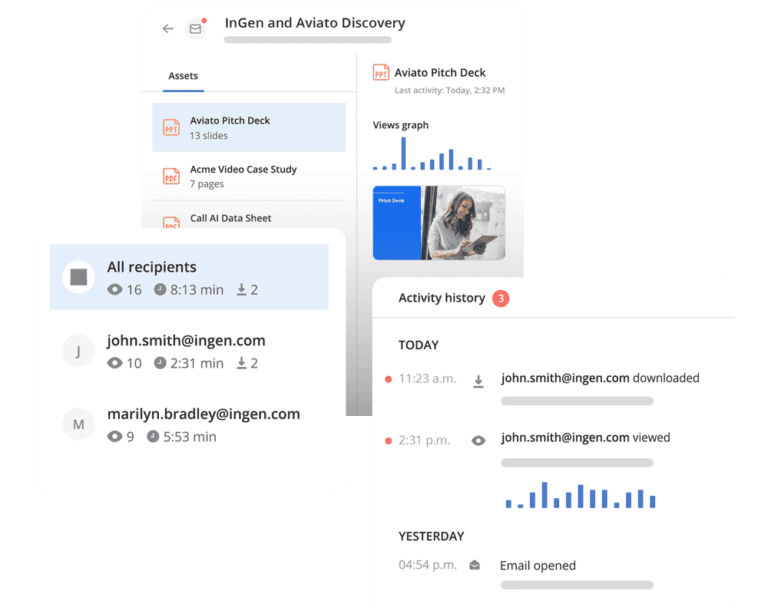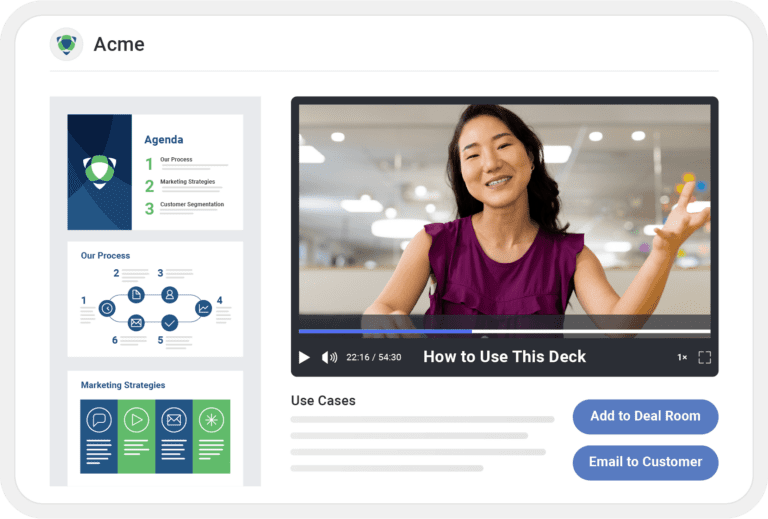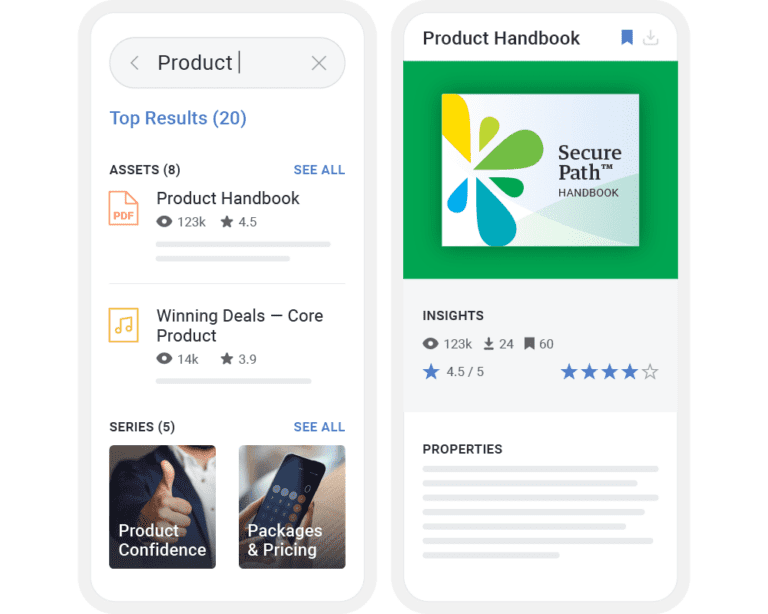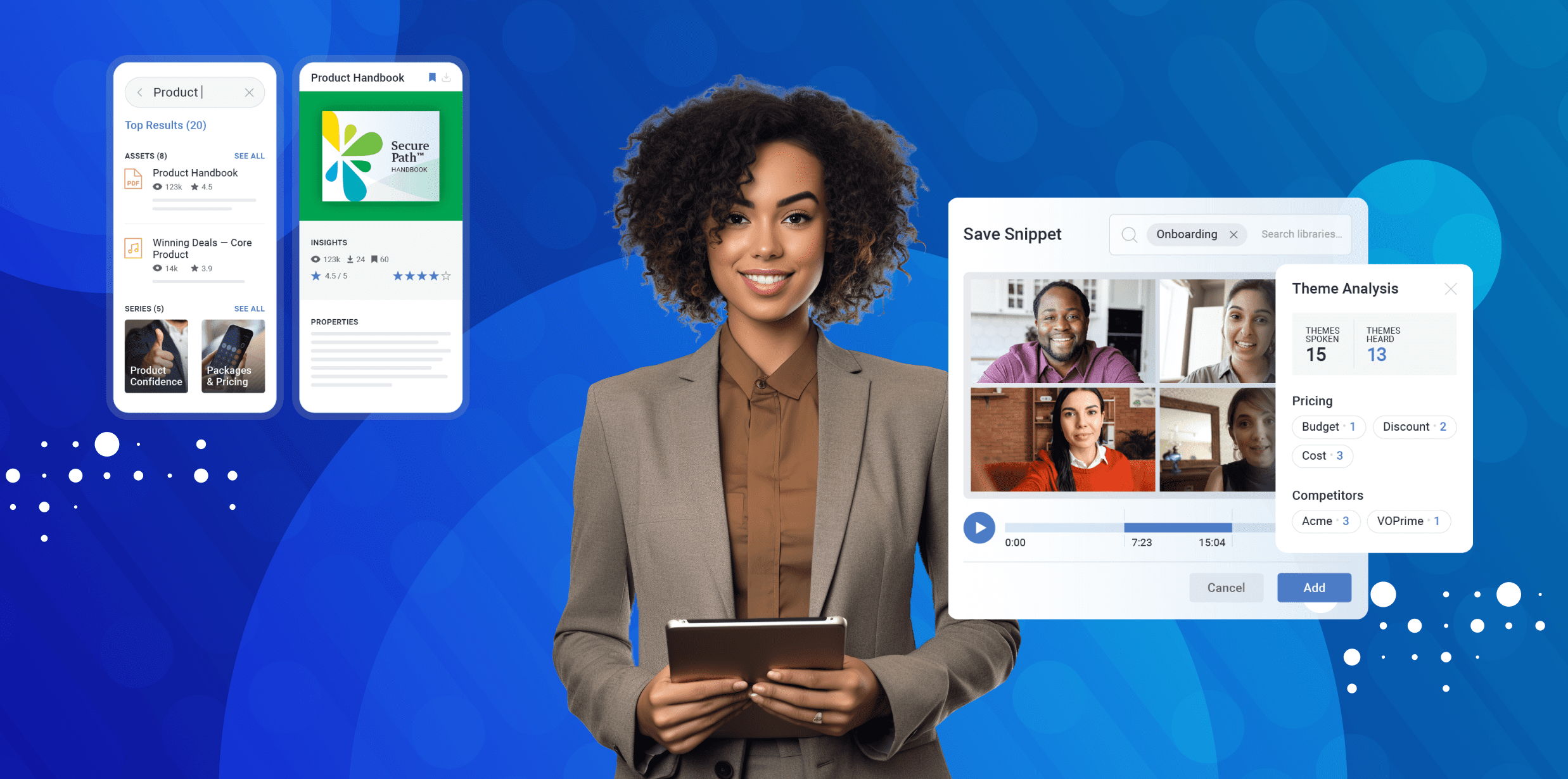When it comes to B2B sales, content is still king. According to the Demand Gen Report, more than half of B2B buyers rely on sales content to guide their purchase decisions more now than in the past.
Revenue organizations have heard the message loud and clear, and most invest time and effort in producing content for their sellers to use throughout the sales cycle. According to the recently released State of Revenue Productivity Report, organizations published an average of 642 new assets in 2023.
But simply producing a large volume of sales content doesn’t mean it’ll be used – or that it’ll make a difference in deal outcomes. Instead, you must understand how sales reps and prospects are (or aren’t) using sales content. In other words, you need sales content analytics.
In fact, without sales content analytics, you’re likely sinking time and money into content that has little to no impact on sales performance.
In this post, we’ll explore sales content analytics, why they’re important for driving B2B sales performance, and which analytics you need to start tracking immediately.
What is sales content analytics?
The harsh reality is that most B2B sales content ends up on the shelf. According to Forrester, an estimated 65% of B2B content isn’t used. For those keeping track, that means 417 pieces of content each year go completely unused by the sales team.
According to Forrester
With sales content management analytics, you can spend your time and effort creating content that will be used and improve sales outcomes. But what is sales content analytics?
Sales content analytics is the practice of analyzing the performance of the different types of sales content your revenue team uses. These include sales presentations, sales collateral, whitepapers, case studies, videos, or any other type of content used throughout the sales cycle.
Sales content analytics can help you understand:
- How often a piece of content is used by sales reps
- How and when sellers share a piece of content with buyers
- How buyers consume the content
- How (and whether) the content influences revenue
- Which teams and sellers get the most customer engagement from the content they share
Revenue organizations can leverage content analytics to optimize their sales content strategy. For example, teams can use these insights to understand when there are opportunities to:
- Update existing content to improve performance
- Eliminate unused or underperforming content
- Create new content
Content analytics can also help organizations determine where additional sales training and sales enablement are needed. For example, let’s say an organization finds that its best sellers frequently use a specific piece of sales content to close deals. However, this piece of content isn’t used widely across the sales team. The revenue organization can use this intel to deliver sales training or sales enablement to help all sellers understand when and how to use this piece of content in the sales cycle.
Sales content analytics are also hugely beneficial to sales reps – which we’ll cover in more detail next.
How does sales content analytics help your B2B sales team?
Today, businesses tap into analytics to make better decisions and improve performance. Their efforts are paying off. A survey from PwC found that highly data-driven organizations are three times more likely to report significant improvements in decision-making.
Data-driven orgs are
Revenue organizations are no exception to this rule. With the right sales analytics, revenue teams can make better decisions – and improve outcomes.
Sales content analytics, which is a type of sales analytics, enable sellers to be more effective and efficient in their roles. Let’s take a closer look at some of the key ways sales content analytics can improve sales rep performance.
Content analytics inform more effective training and enablement
On every B2B sales team, there’s a subset of top performers. Content analytics helps you understand what your top sellers are doing with content so your entire team can adopt these winning behaviors.
For example, you may find that one of your top sellers uses a specific piece of sales content every time they close a deal in a specific industry. However, the entire sales team hasn’t widely adopted this content. You can use these insights to deliver training and sales enablement focused on helping all sellers understand how to use this particular piece of content.
Sales content analytics help reps determine the next best action
Chances are, your sellers follow an established sales process for every deal. However, the sales process must be flexible enough to allow sellers to deliver personalized experiences that resonate with each buyer.

Content analytics provide valuable information that B2B sales reps can use to determine what action to take next. For example, a sales rep can examine content analytics to see how (or whether) different buying committee members are engaging with the content they’ve shared. These insights can help the sales rep determine the next best action.
Sales content analytics helps drive deal acceleration
Sales content helps reps close more deals. But not just any content will do. Instead, reps need relevant, proven content for each customer – no matter where they are on the sales journey.
With sales content analytics, revenue teams can understand how content is being used and whether it’s impacting deals. Then, they can use these insights to invest in content that’s proven to accelerate deals.


For example, content analytics may reveal that certain pieces of content are never used. This content can be eliminated altogether.
Content analytics can also illuminate opportunities to freshen up existing content and boost its effectiveness. According to the recently released State of Revenue Productivity Report, the top 10% of revenue organizations update their content at least every 3.25 months.
The right sales content analytics can also help organizations understand where new content is needed. For example, you may find that deals frequently drop off at a certain point in the sales cycle, and the existing assets for that stage aren’t as effective as you’d hoped. You can use data—as well as feedback from your sales team—to develop new content for sellers to use.
The bottom line is that sales content analytics enables organizations to improve the effectiveness of their sales content. That means sellers are equipped with proven-to-work sales content. When sellers use this content, they’re more likely to close deals faster.
Sales content analytics help create a culture of data-driven decision-making
Making decisions based on hunches or gut feelings isn’t an effective approach. Instead, business decisions must be rooted in data.
Revenue organizations should strive to build a culture where data-driven decision-making is the norm. Equipping the right people with the right sales content analytics is a key way to make this a reality.
What sales content metrics do you need to track?
Now you know what sales content analytics is and why it’s important to revenue organizations. But what content metrics do you need to track to understand how your content is being used and what kind of impact it has on deals?
Let’s take a closer look at some of the top sales content metrics. Ideally, you should be able to access these metrics via your sales content management solution.
Searches
Track what keywords your reps are using when searching for the right content. You can leverage this information to categorize better or tag your existing sales content assets.
In addition, look for trends in reps’ searches. If sellers’ searches turned up no results, there may be an opportunity to develop new sales content.


Finally, be sure to monitor whether the content reps find during their searches is effective. In other words, ask yourself if buyers are engaging with this content and whether it’s creating opportunities for sellers.
Sales content usage
You may have spent a lot of time creating great content. But if your sellers aren’t using it, your prospects will never see it.
Content usage metrics help you understand how (or if) sales reps use a particular piece of content. Key metrics include things like:
- Sales content views
- Sales content downloads
- Sales content edits
- Sales content shares
You can track sales content usage metrics across the whole revenue team, as well as by region, territory, or individual rep.
Sales content engagement
The right content helps accelerate B2B deals. However, content must be relevant and engaging to be effective.
As such, it’s important to track sales content engagement, which measures how your buyers consume your sales content. There are several metrics you need to track to understand sales content engagement, including:
- Clickthrough rate
- Average amount of time buyers spend engaging with a specific piece of content
- How often buyers engage with a piece of content
- How many pages or sections the buyer engage with, and which pages or sections get the most engagement
- How often buyers are sharing a piece of content with others
- Which sales reps have the highest engagement on sales content
Sales content production timeline
Producing content requires time and effort. Be sure to track the amount of time it takes to create sales content. This metric will be important when determining whether the results are worth the time and effort spent on it.
Sales content performance and ROI
You want to invest in content that improves sales outcomes. As such, it’s important to measure sales content performance and ROI.
You can use these insights to invest more in content that’s proven to work.
Be sure to track which content buyers are engaging with at each stage of the sales cycle and how it’s impacting whether or not they continue through the funnel. You should also track which content is used in both closed-won and closed-lost opportunities – and the impact the content had on each deal.
Feedback from the sales team
When it comes to sales content optimization, hard data is key. However, it’s also important to ask for feedback from your sales teams, as they meet with customers daily. Your sales reps – especially your top performers – have unique insight into which content works, which doesn’t, and where there are opportunities to develop new assets to accelerate the sales cycle and improve sales outcomes.
Leverage sales content metrics to optimize your sales content with Mindtickle
Sales content is a key component of the B2B purchase journey. But without sales content analytics, it’s impossible to know how content is being used by buyers and sellers, and how it’s impacting the outcome of deals.
If you’re not using sales content analytics, you spend time, money, and effort on content with little to no impact. So, while your sellers have plenty of content, it’s ineffective, and they may lose deals because of it.
It’s time to start leveraging sales content analytics to understand how buyers and sellers are engaging with content today and how you can optimize for greater engagement and impact.
Mindtickle’s integrated revenue productivity platform incorporates sales content management tools, which ensures your sales reps can easily surface the right content for the right selling scenario.
Mindtickle’s sales content management platform also features robust analytics to help you understand how sales reps and prospects engage with content and how various assets influence sales outcomes. Revenue organizations can use these insights to improve the effectiveness of their content and deliver sales training and sales enablement to ensure reps know how and when to use content that’s proven to drive revenue.
Sales Content Analytics in Mindtickle
Curious why winning revenue organizations turn to Mindtickle to create better sales content that positively impacts revenue? See for yourself.
Get Your Demo






